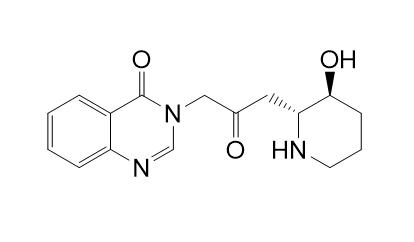Febrifugine
Febrifugine is an effective coccidiostat, possesses schizonticide props; it and its derivatives shows high degree of antimalarial activity but use limited by toxicity .
Inquire / Order:
manager@chemfaces.com
Technical Inquiries:
service@chemfaces.com
Tel:
+86-27-84237783
Fax:
+86-27-84254680
Address:
1 Building, No. 83, CheCheng Rd., Wuhan Economic and Technological Development Zone, Wuhan, Hubei 430056, PRC
Providing storage is as stated on the product vial and the vial is kept tightly sealed, the product can be stored for up to
24 months(2-8C).
Wherever possible, you should prepare and use solutions on the same day. However, if you need to make up stock solutions in advance, we recommend that you store the solution as aliquots in tightly sealed vials at -20C. Generally, these will be useable for up to two weeks. Before use, and prior to opening the vial we recommend that you allow your product to equilibrate to room temperature for at least 1 hour.
Need more advice on solubility, usage and handling? Please email to: service@chemfaces.com
The packaging of the product may have turned upside down during transportation, resulting in the natural compounds adhering to the neck or cap of the vial. take the vial out of its packaging and gently shake to let the compounds fall to the bottom of the vial. for liquid products, centrifuge at 200-500 RPM to gather the liquid at the bottom of the vial. try to avoid loss or contamination during handling.
Journal of Holistic Integrative Pharmacy2024, 5(1):45-55.
Plants (Basel).2023, 12(5):1120.
Int Immunopharmacol.2022, 106:108603.
Enzyme and Microbial Technology2022, 110002.
Foods.2023, 12(19):3647.
Phytother Res.2019, 33(5):1490-1500
J Pharm Biomed Anal.2017, 140:274-280
EXCLI J.2023, 22:482-498.
Horticulturae2022, 8(10), 975.
Biomed Pharmacother.2022, 146:112497.
Related and Featured Products
Sci Transl Med. 2015 May 20;7(288):288ra77.
The cytoplasmic prolyl-tRNA synthetase of the malaria parasite is a dual-stage target of febrifugine and its analogs.[Pubmed:
25995223]
The emergence of drug resistance is a major limitation of current antimalarials. The discovery of new druggable targets and pathways including those that are critical for multiple life cycle stages of the malaria parasite is a major goal for developing next-generation antimalarial drugs.
METHODS AND RESULTS:
Using an integrated chemogenomics approach that combined drug resistance selection, whole-genome sequencing, and an orthogonal yeast model, we demonstrate that the cytoplasmic prolyl-tRNA (transfer RNA) synthetase (PfcPRS) of the malaria parasite Plasmodium falciparum is a biochemical and functional target of Febrifugine and its synthetic derivative halofuginone. Febrifugine is the active principle of a traditional Chinese herbal remedy for malaria. We show that treatment with Febrifugine derivatives activated the amino acid starvation response in both P. falciparum and a transgenic yeast strain expressing PfcPRS. We further demonstrate in the Plasmodium berghei mouse model of malaria that halofuginol, a new halofuginone analog that we developed, is active against both liver and asexual blood stages of the malaria parasite.
CONCLUSIONS:
Halofuginol, unlike halofuginone and Febrifugine, is well tolerated at efficacious doses and represents a promising lead for the development of dual-stage next-generation antimalarials.
Southeast Asian J Trop Med Public Health. 2008 Nov;39(6):949-58.
Possible involvement of IFN-gamma in early mortality of Plasmodium berghei NK65-infected BALB/c mice after febrifugine treatment.[Pubmed:
19062681]
METHODS AND RESULTS:
Parasitemia patterns, survival and cytokine levels of Plasmodium berghei NK65-infected BALB/c mice, treated orally with the alkaloidal mixture of Febrifugine and isoFebrifugine at a dose of 1 mg/kg twice a day for 4 consecutive days were monitored. Whereas the untreated mice showed a progressive increase in parasitemia and ultimate death, the alkaloid mixture-treated group showed a transient suppression of parasitemia during the course of treatment. However, the parasitemia increased on discontinuation of treatment, leading to earlier death of mice in the treated group than in the infected but untreated controls. Mice in the infected but untreated group displayed a significant elevation in serum IFN-gammay levels during the first week post-infection (pI) and from Day 14 pI, relative to the levels in the uninfected controls. In contrast, although mice in the alkaloid mixture-treated group displayed no significant elevation in serum IFN-gamma levels during the first week pI, they showed considerable levels on Day 14 pI. There were no significant differences in serum IL-4 levels among the groups. The titers of the parasite-specific IgG1, IgG2a, IgG2b and IgG3 were significantly elevated from Day 11 pI in both the treated and untreated groups. There was a significant difference in survival duration between the IFN-gamma-/- mutant and BALB/c mice. IFN-gamma-/- mutant mice showed a decrease in parasitemia levels while receiving medication, which was significantly lower than those of the treated BALB/c mice.
CONCLUSIONS:
The results of the present study suggest that although IFN-gamma is significant for protective immunity in mice with malaria infection, it may play an adverse role post-medication, causing earlier mortality of treated BALB/c mice.
J Adv Pharm Technol Res. 2013 Jan;4(1):50-60.
Pharmacophore modeling and 3D quantitative structure-activity relationship analysis of febrifugine analogues as potent antimalarial agent.[Pubmed:
23662282]
Febrifugine and its derivatives are effective against Plasmodium falciparum.
METHODS AND RESULTS:
Using PHASE algorithm, a five-point pharmacophore model with two hydrogen bond acceptor (A), one positively ionizable (P) and two aromatic rings (R), was developed to derive a predictive ligand-based statistically significant 3D-quantitative structure-activity relationship (QSAR) model (r(2) = 0.972, SD = 0.3, F = 173.4, Q(2) = 0.712, RMSE = 0.3, Person-R = 0.94, and r(2) pred = 0.8) to explicate the structural attributes crucial for antimalarial activity.
CONCLUSIONS:
The developed pharmacophore model and 3D QSAR model can be a substantial tool for virtual screening and related antimalarial drug discovery research.



